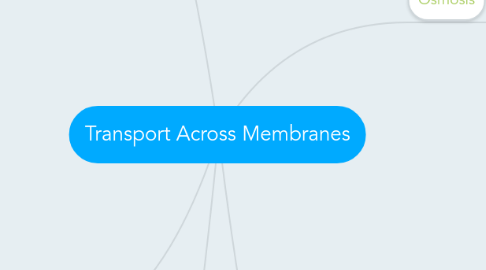
1. Diffussion
1.1. Diffusion is the movement of molecules from a region of high concentration to a region of low concentration until they are evenly spread out
1.2. Occurs down a concentration gradient
1.3. Diffusion is a passive process
1.3.1. Meaning that NO ENERGY IS NEEDED by the cell
1.4. Diffusion is the main process involved when molecules pass through cell membranes
1.5. Diffusion and Cells
1.5.1. Dissolved food
1.5.1.1. Moves into the cell from high concentration to low concentration
1.5.2. Dissolved Oxygen
1.5.2.1. Moves into the cell from high concentration to low concentration
1.5.3. Dissolved Carbon Dioxide
1.5.3.1. Moves into the cell from high concentration to low concentration
2. The Cell Membrane
2.1. An organelle is a structure found within cells that is surrounded by a Cell Membrane
2.2. The Cell Membrane is fluid and constantly moving
2.3. Composed of Proteins and Phospholipids
2.3.1. Phospholipids
2.3.1.1. The Phospholipid's head is hydrophilic which means it is attracted to water
2.3.1.2. The Phospholipid's the tail is hydrophobic which means it hates water
2.3.2. Proteins
2.3.2.1. They form pores in the Cell Membrane allowing small molecules to pass through
2.3.2.2. They act as carriers which 'actively' pump molecules across the membrane
2.3.2.3. They serve as enzymes
2.3.2.4. They act as receptors for hormones arriving at the cell
2.3.2.5. They serve as antigenic markers identifying blood type or tissue type
2.4. The Cell Membrane is semi-permeable
2.4.1. Meaning that only some substances can pass through
3. Active Transport
3.1. Active Transport moves molecules from a low concentration to a high concentration
3.2. Requires energy for membrane proteins to move molecules against the concentration gradient in order to maintain the gradient
4. Osmosis
4.1. Osmosis is the movement of water molecules from high concentration to a low concentration, along a concentration gradient and through a selectively permeable membrane
4.2. Osmosis is a form of diffusion
4.3. Osmosis is a passive process
4.3.1. Meaning that NO ENERGY IS NEEDED by the cell
4.4. Plant Cells
4.4.1. Potato Cell
4.4.1.1. Cell after being in an isotonic solution (normal cell)
4.4.1.1.1. How the cell is affected
4.4.1.1.2. Cell is described as unchanged
4.4.1.2. Cell after being in a hypotonic solution
4.4.1.2.1. How the cell is affected
4.4.1.2.2. Cell described as fully turgid
4.4.1.3. Cell after being in a hypertonic solution
4.4.1.3.1. How the cell is affected
4.4.1.3.2. This process of extreme water loss from a plant cell is call plasmolysis
4.4.1.3.3. Plasmolysed cells are described as flaccid
4.5. Animal Cells
4.5.1. Blood Cell
4.5.1.1. Cell after being in an isotonic solution (normal cell)
4.5.1.1.1. Remains unchnaged
4.5.1.2. Cell after being in a hypotonic solution
4.5.1.2.1. Swells and Bursts
4.5.1.3. Cell after being in a hypertonic solution
4.5.1.3.1. Shrinks
5. Water Concentration
5.1. Isotonic
5.1.1. An Isotonic solution has a water concentration which is EQUAL to the water concentration within the cell
5.2. Hypotonic
5.2.1. A Hypotonic solution has a HIGHER water concentration than the water concentration within the cell
5.3. Hypertonic
5.3.1. A Hypertonic solution has a LOWER water concentration than the water concentration within the cell

